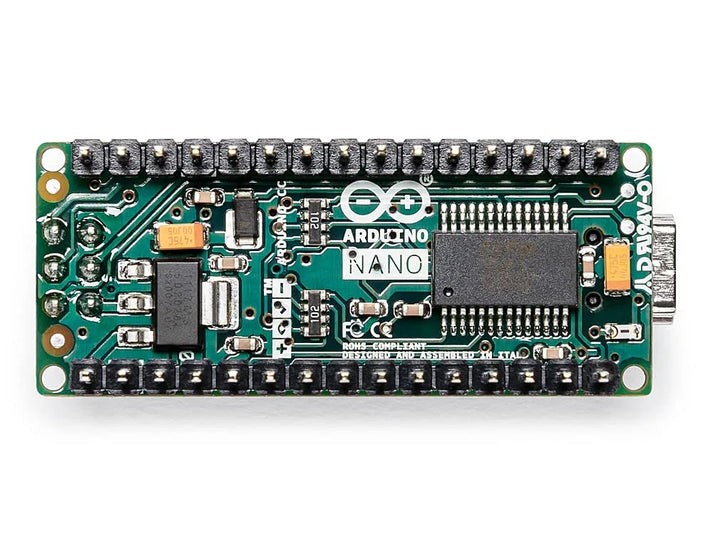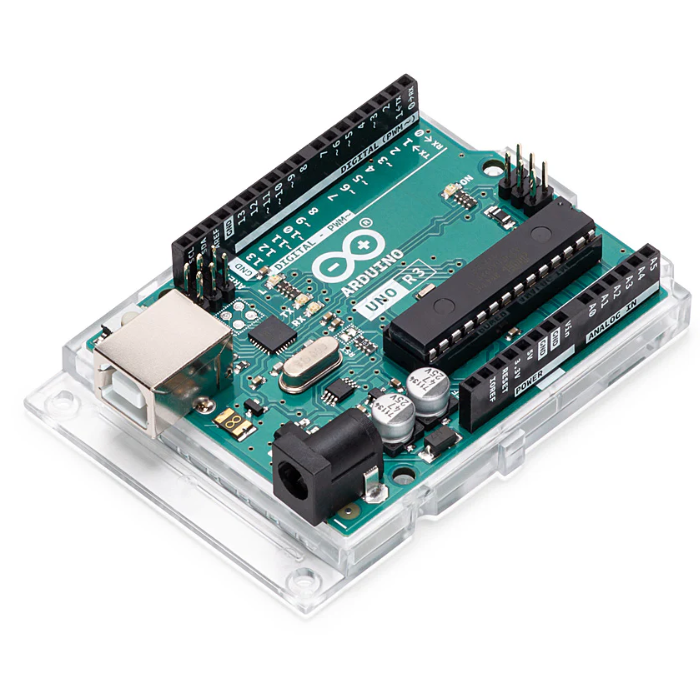Arduino Nano Original A000005
The Arduino Nano is a compact, open-source development board based on ATmega328P, an 8-bit AVR microcontroller.
It has 14 digital I/O pins, 8 analog input pins with 10-bit resolution, 2 reset pins, and 6 power pins, making it perfect for space-constrained projects that require fewer GPIOs and memory.
The Arduino Nano board operates at 5V, supports an input voltage of 6V–20V (recommended: 7V–12V), and runs at a 16 MHz clock frequency. Unlike most Arduino boards, it uses a mini USB port and lacks a DC power jack, so it cannot be powered through an external jack.
Fully breadboard-friendly, the Nano is perfect for quick prototyping. It offers flash memory of 32KB (with 2KB used by the bootloader), EEPROM of 512B/1KB, and SRAM of 1KB/2KB, depending on the microcontroller.
The Arduino Nano microcontroller delivers Arduino Uno-like performance in a smaller, more project-ready form.
What’s so special about Arduino Nano? Find out!
Arduino Nano Pin Diagram
| Pin |
Description |
| Digital Pins (0–13) |
14 digital I/O pins for connecting external components. |
| Analog Pins (A0–A5) |
6 analog input pins to measure voltage from 0 to 5V. |
| LED (Pin 13) |
Built-in LED connected to digital pin 13. |
| VIN |
External input voltage pin (6–12V recommended). |
| 3.3V |
Low voltage output from the on-board regulator. |
| 5V |
Regulated 5V output to power components. |
| AREF |
Analog reference voltage input for analog readings. |
| GND |
2 ground pins for grounding the circuit. |
| Reset |
2 reset pins to reset the controller via software. |
| External Interrupts |
Pin 2 and 3 can trigger external interrupts in emergencies. |
| USART |
Rx and Tx pins for serial data communication. |
| I2C |
SDA and SCL pins for I2C communication using the Wire library. |
| SPI |
SS, MISO, MOSI, SCK pins used for SPI communication with peripherals. |
Applications:
- Automation.
- Robotics.
- Control Systems.
- Embedded Computer.
Arduino Nano vs Uno Comparison Table
| Feature |
Arduino Nano

|
Arduino UNO R3

|
| Price (Robocraze) |
?1,798 |
?1,860 VIEW
|
| Microcontroller |
ATmega328P |
ATmega328P |
| Operating Voltage |
5V |
5V |
| Input Voltage |
7-12V |
7-12V |
| Digital I/O Pins |
14 (6 PWM) |
14 (6 PWM) |
| Analog Input Pins |
8 |
6 |
| Clock Speed |
16 MHz |
16 MHz |
| Flash Memory |
32 KB (0.5 KB used by bootloader) |
32 KB (0.5 KB used by bootloader) |
| SRAM |
2 KB |
2 KB |
| EEPROM |
1 KB |
1 KB |
| USB Interface |
Mini USB |
Standard USB Type-B |
| Size |
Compact (approx. 45mm x 18mm) |
Larger (approx. 68.6mm x 53.4mm) |
| Best for |
Compact projects, breadboard-friendly applications |
Beginners, shields, projects needing standard size |
| Wireless Capability |
Needs external module (e.g., ESP8266, HC-05) |
Needs external module (e.g., ESP8266, HC-05) |
| Expandable with Shields |
Limited due to size constraints |
Yes, compatible with multiple shields |
































